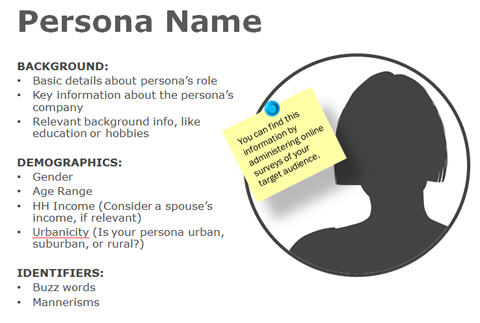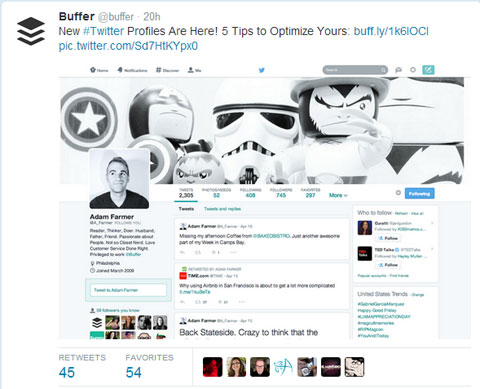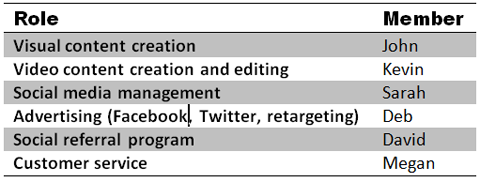 Do you need help getting started with your social media marketing strategy?
Do you need help getting started with your social media marketing strategy?
Do you know what to include?
Goals and objectives guide your social media strategy to help you successfully connect with your customers.
In this article I'll share what you need to include in your social media marketing strategy so it works from day one.
#1: Identify Business Goals
Every piece of your social media strategy serves the goals you set. You simply can't move forward without knowing what you're working toward.
Look closely at your company's overall needs and decide how you want to use social media to contribute to reaching them.
You'll undoubtedly come up with several personalized goals, but there are a few that all companies should include in their strategy—increasing brand awareness, retaining customers and reducing marketing costs are relevant to everyone.

I suggest you choose two primary goals and two secondary goals to focus on. Having too many goals distracts you and you'll end up achieving none.
#2: Set Marketing Objectives
Goals aren't terribly useful if you don't have specific parameters that define when each is achieved. For example, if one of your primary goals is generating leads and sales, how many leads and sales do you have to generate before you consider that goal a success?
Marketing objectives define how you get from Point A (an unfulfilled goal) to Point B (a successfully fulfilled goal). You can determine your objectives with the S-M-A-R-T approach: Make your objectives specific, measurable, achievable, relevant and time-bound.

Using our previous example, if your goal is to generate leads and sales, a specific marketing objective may be to increase leads by 50%. In order to measure your progress, choose which analytics and tracking tools you need to have in place.
Setting yourself up for failure is never a good idea. If you set an objective of increasing sales by 1,000%, it's doubtful you'll meet it. Choose objectives you can achieve, given the resources you have.
You've taken the time to refine your goals so they're relevant to your company, so extend that same consideration to your objectives. If you want to get support from your C-level executives, ensure your objectives are relevant to the company's overall vision.
Get World-Class Marketing Training — All Year Long!
Are you facing doubt, uncertainty, or overwhelm? The Social Media Marketing Society can help.
Each month, you’ll receive training from trusted marketing experts, covering everything from AI to organic social marketing. When you join, you’ll also get immediate access to:
- A library of 100+ marketing trainings
- A community of like-minded marketers
- Monthly online community meetups
- Relevant news and trends updates
Attaching a timeframe to your efforts is imperative. When do you intend to achieve your goal(s)? Next month? By the end of this year?
Your objective of increasing leads by 50% may be specific, measurable, achievable and relevant, but if you don't set a deadline for achieving the goal, your efforts, resources and attention may be pulled in other directions.
#3: Identify Ideal Customers
If a business is suffering from low engagement on their social profiles, it's usually because they don't have an accurate ideal customer profile.
Buyer personas help you define and target the right people, in the right places, at the right times with the right messages.
When you know your target audience's age, occupation, income, interests, pains, problems, obstacles, habits, likes, dislikes, motivations and objections, then it's easier and cheaper to target them on social or any other media.

The more specific you are, the more conversions you're going to get out of every channel you use to promote your business.
#4: Research Competition
When it comes to social media marketing, researching your competition not only keeps you apprised of their activity, it gives you an idea of what's working so you can integrate those successful tactics into your own efforts.
Start by compiling a list of at least 3-5 main competitors. Search which social networks they're using and analyze their content strategy. Look at their number of fans or followers, posting frequency and time of day.
Also pay attention to the type of content they're posting and its context (humorous, promotional, etc.) and how they're responding to their fans.
The most important activity to look at is engagement. Even though page admins are the only ones who can calculate engagement rate on a particular update, you can get a good idea of what they're seeing.
For example, let's say you're looking at a competitor's last 20-30 Facebook updates. Take the total number of engagement activities for those posts and divide it by the page's total number of fans. (Engagement activity includes likes, comments, shares, etc.)
You can use that formula on all of your competitors' social profiles (e.g., on Twitter you can calculate retweets and favorites).
Keep in mind that the calculation is meant to give you a general picture of how the competition is doing so you can compare how you stack up against each other.

Discover Proven Marketing Strategies and Tips
Want to go even deeper with your marketing? Check out the Social Media Marketing Podcast! Publishing weekly since 2012, the Social Media Marketing Podcast helps you navigate the constantly changing marketing jungle, with expert interviews from marketing pros.
But don’t let the name fool you. This show is about a lot more than just social media marketing. With over 600 episodes and millions of downloads each year, this show has been a trusted source for marketers for well over a decade.
#5: Choose Channels and Tactics
Many businesses create accounts on every popular social network without researching which platform will bring the most return. You can avoid wasting your time in the wrong place by using the information from your buyer personas to determine which platform is best for you.
If your prospects or customers tell you they spend 40% of their online time on Facebook and 20% on Twitter, you know which primary and secondary social networks you should focus on.
When your customers are using a specific network, that's where you need to be—not everywhere else.
Your tactics for each social channel rely on your goals and objectives, as well as the best practices of each platform.

For example, if your goal is increasing leads and your primary social network is Facebook, some effective tactics are investing in Facebook advertising or promotion campaigns to draw more attention to your lead magnets.
#6: Create a Content Strategy
Content and social media have a symbiotic relationship: Without great content social media is meaningless and without social media nobody will know about your content. Use them together to reach and convert your prospects.
There are three main components to any successful social media content strategy: type of content, time of posting and frequency of posting.
The type of content you should post on each social network relies on form and context. Form is how you present that information—text only, images, links, video, etc.

Context fits with your company voice and platform trends. Should your content be funny, serious, highly detailed and educational or something else?
There are many studies that give you a specific time when you should post on social media. However, I suggest using those studies as guidelines rather than hard rules. Remember, your audience is unique, so you need to test and figure out the best time for yourself.
Posting frequency is as important as the content you share. You don't want to annoy your fans or followers, do you?
Finding the perfect frequency is crucial because it could mean more engagement for your content or more unlikes and unfollows. Use Facebook Insights to see when your fans are online and engaging with your content.
#7: Allocate Budget and Resources
To budget for social media marketing, look at the tactics you've chosen to achieve your business goals and objectives.
Make a comprehensive list of the tools you need (e.g., social media monitoring, email marketing and CRM), services you'll outsource (e.g., graphic design or video production) and any advertising you'll purchase. Next to each, include the annual projected cost so you can have a high-level view of what you're investing in and how it affects your marketing budget.
Many businesses establish their budget first, and then select which tactics fit that budget. I take the opposite approach. I establish a strategy first, and then determine the budget that fits that strategy.
If your strategy execution fees exceed your budget estimate, prioritize your tactics according to their ROI timeframe. The tactics with the fastest ROI (e.g., advertising and social referral) take priority because they generate instant profit you can later invest into long-term tactics (fan acquisition, quality content creation or long-term engagement).
#8: Assign Roles
Knowing who's responsible for what increases productivity and avoids confusion and overlapping efforts. Things may be a bit messy in the beginning, but with time team members will know their roles and what daily tasks they're responsible for.

When everyone knows his or her role, it's time to start planning the execution process. You can either plan daily or weekly. I don't advise putting a monthly plan together because lots of things will come up and you may end up wasting time adapting to the new changes.
You can use tools like Basecamp or ActiveCollab to manage your team and assign tasks to each member. These tools save you tons of time and help you stay organized.
Your Turn
Your social media marketing strategy isn't written in stone. As you move forward, you may discover that some tactics are not working as well as you thought they would. Always try to adapt quickly and introduce the new changes to your overall strategy.
What do you think? Do you have a clear social media strategy? What tools do you use to keep your team moving ahead? I would love to hear your thoughts, questions or comments on this process. Please leave them in the comment section below!
Goal on Blackboard photo from Shutterstock.
Colorful Business Graph on White Background photo from Shutterstock.
Attention Agency Owners, Brand Marketers, and Consultants

Introducing the Marketing Agency Show–our newest podcast designed to explore the struggles of agency marketers.
Join show host and agency owner, Brooke Sellas, as she interviews agency marketers and digs deep into their biggest challenges. Explore topics like navigating rough economic times, leveraging AI, service diversification, client acquisition, and much more.
Just pull up your favorite podcast app, search for Marketing Agency Show and start listening. Or click the button below for more information.

